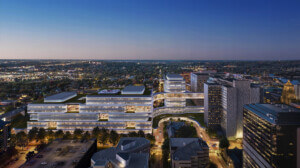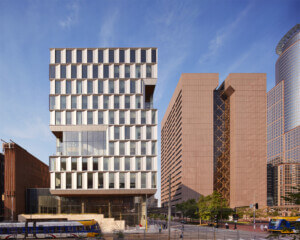Designed by Henning Larsen and MSR Design, the Minneapolis Public Service Building (PSB) is an innovative urban model for government access. Programmed to house nine city departments previously scattered over seven sites, it is one of the finest examples of contemporary architecture built in downtown Minneapolis since Johnson/Burgee’s mixed-use IDS Center opened in 1971. Yet the PSB was designed in what now seems a distant time.
In the lives of cities, five or six years can pass with the blink of an eye. The PSB was underway before the murder of George Floyd at the hands of city police in May 2020, an event which showcased longstanding issues of discrimination and police brutality in Minneapolis. Today, the city continues to grapple with public safety, equity, rebuilding trust, and addressing a troubled past.
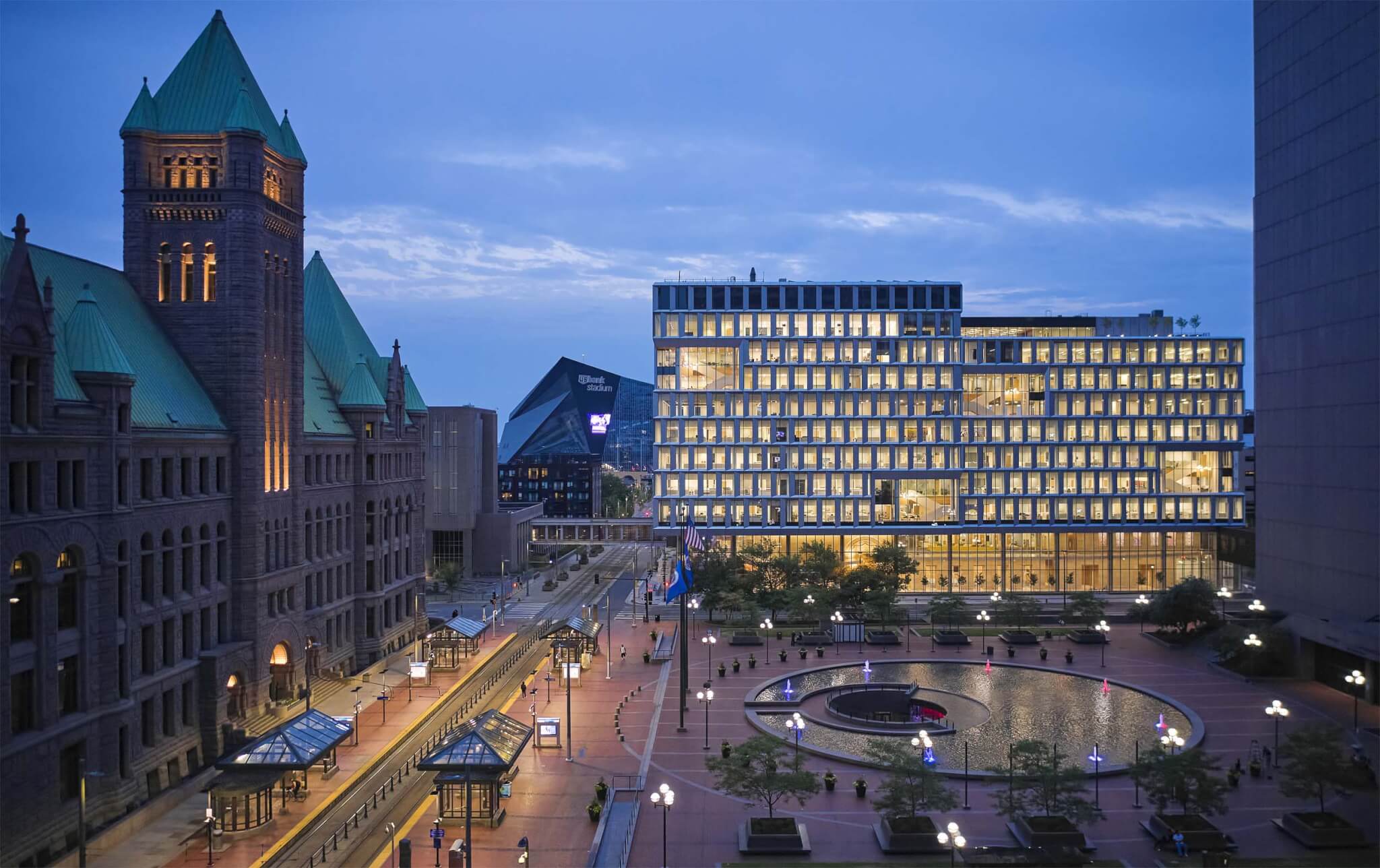
A whirlwind of global events in the last five years—during which the PSB was programmed, designed, and built—show its adaptability and long-term endurance. The PSB offers is a brilliant model for direct access for residents to city services and specialists, but it opened at the peak of the COVID-19 pandemic just as many city employees—whose quality of work environment was the top design priority—began working from home. Some still are.
Yet these changes have not made the PSB obsolete. In fact, the deeply thought-out design goals and details of this green, health-conscious civic building give it the resiliency to adapt with new demands.
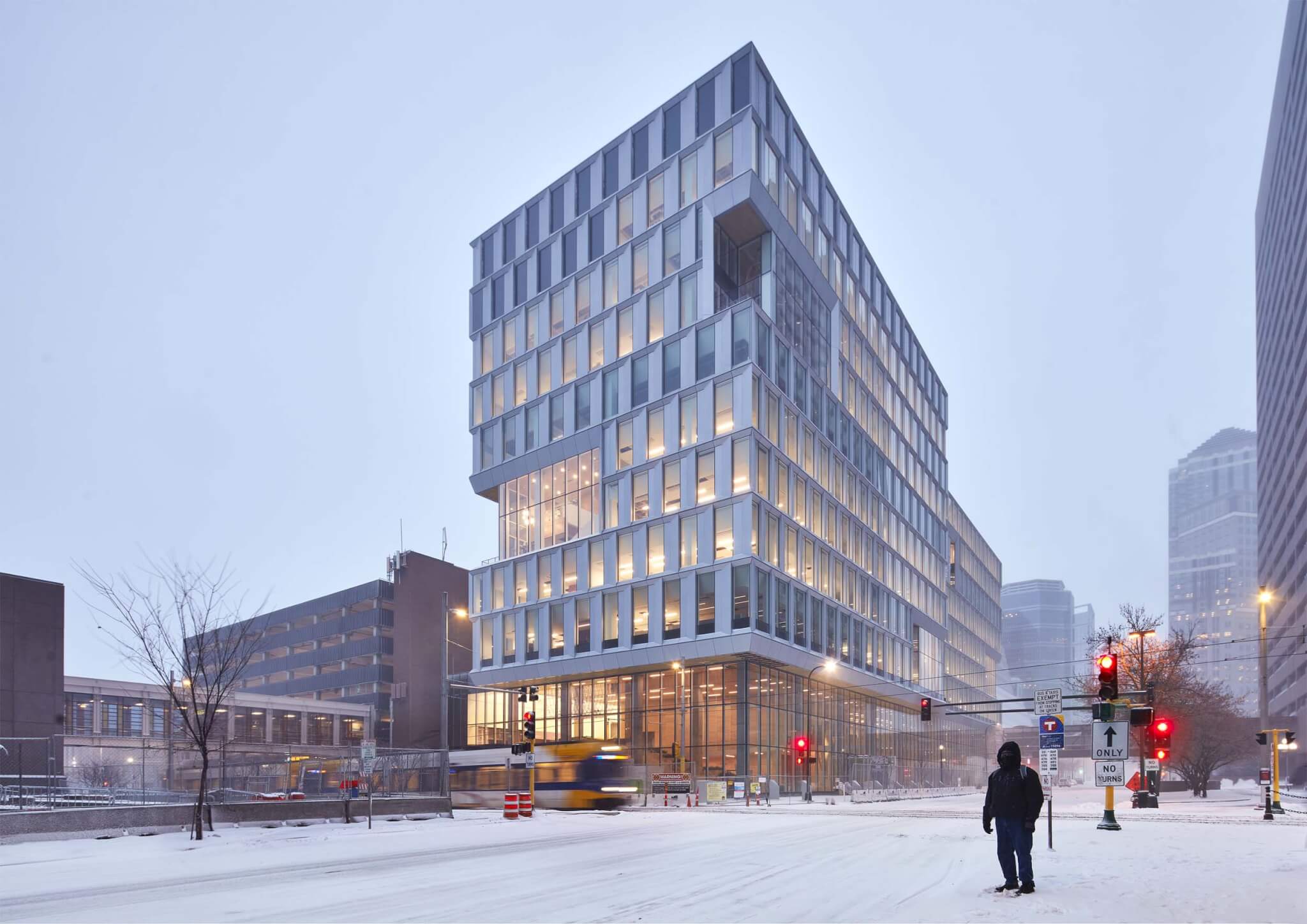
With its 370,000 square feet spread over 11 floors, the PSB is the result of architectural partnership of the New York office of the Denmark-headquartered firm Henning Larsen as design architect and the Minneapolis-based MSR Design as architect of record.
Michael Sørensen, design director for North America at Henning Larsen, told AN that the PSB project came in the early days of the firm’s newly opened office in New York City. The timing was ideal. “At the time in our Copenhagen office, we had been working on a number of city halls throughout the past ten years around Scandinavia,” he explains. This knowledge was put to good use on a new continent.
In the profession today, clients and the media often assume that for prominent projects (like this one) there is lack of creative exchange among design teams. There is a persistent belief that, for example, the out-of-town architect serves as the design lead and the “local” partner firm will implement the vision through design development, construction documents, and on-site administration. The PSB is the result of a far more collaborative process throughout all phases of design and programming. The resulting design, which was recognized this week with a 2023 Architecture award from AIA, is richer because of this team integration and will continue to serve Minneapolis for the next century.
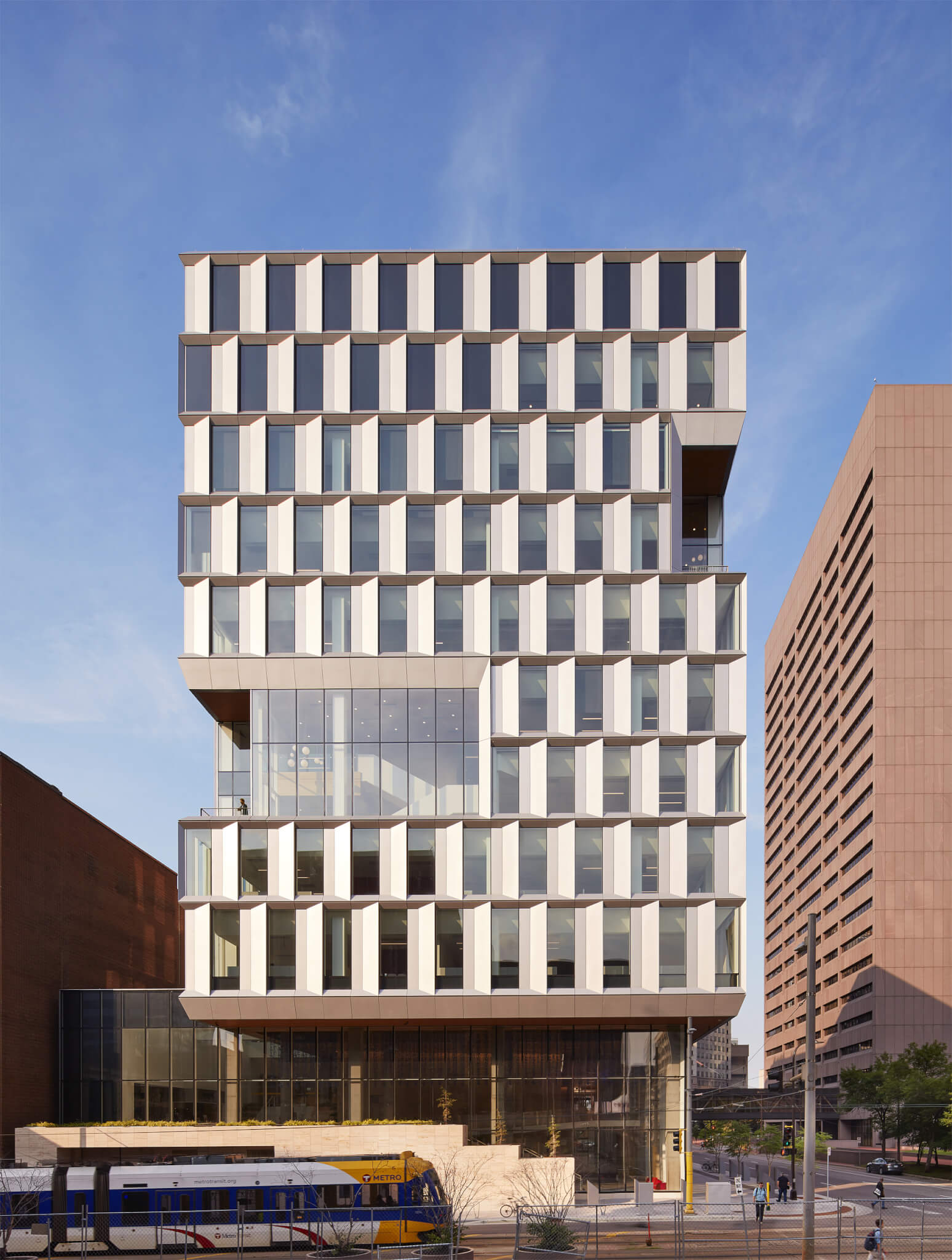
Understanding the City in Winter
Henning Larsen and MSR Design won this commission in part because they studied wind patterns and four-season microclimates at obvious entry points. In a northern city where the wind-chill can drop to -40 degrees Fahrenheit, door placement can make all the difference between a cold or inviting entry. During the interview process, they demonstrated that the presumed front door, opening to the northeast and closest to City Hall, could actually be very cold in winter.
Competing proposals for the building placed the main entry at that location, said Council Member Lisa Goodman, who was a member of the design selection committee. The winning team stood out because “they performed a solar gain and wind study showing that location to be very windy,” she elaborated.
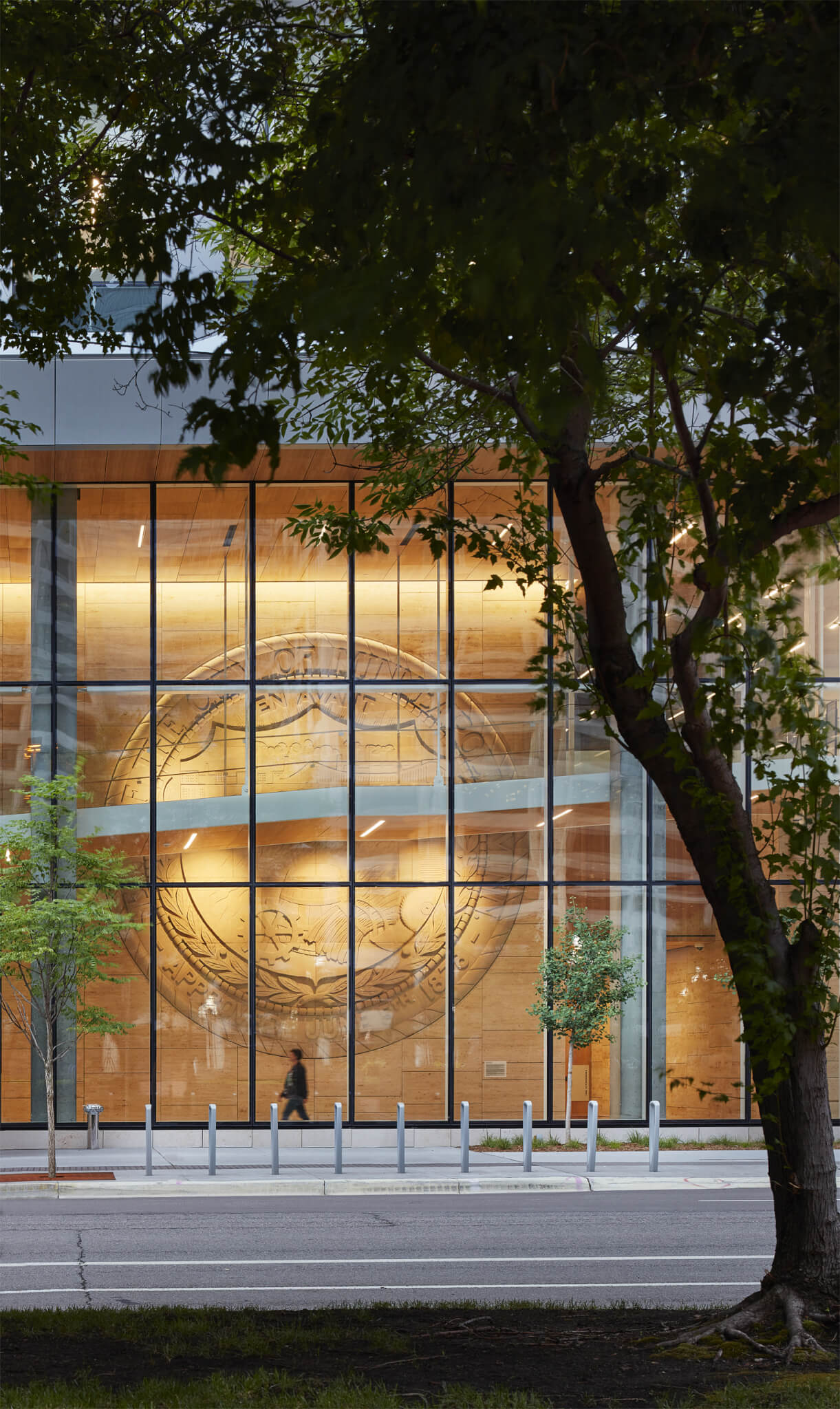
Peter Hendee Brown, an architect and planner who advised the City during the architect interviews and led the community engagement process, said that the Henning Larsen–MSR team “really got our climate. Their microclimatic analysis of the building was not like anything I’d seen before.”
Brown also praised the City for its strong commitment to constructing a sustainable 100-year building that goes far beyond minimum standards. The design team’s international experience and understanding of northern cities proved to be an ideal fit.
As a result of the climate analysis, the designers moved the front door 100 feet west on 4th Avenue to a more sheltered, yet visible and accessible, mid-block location. Sørensen explained that this pivotal study also “prompted us to not only relocate the entrance, but to also treat the public space of the first two floors as an extension of Government Plaza, pulling the public space of the plaza in through this relocated entrance and rolling it up to connect directly to the City’s public skyway system.”
This connective sense of entry opens to an interior two-level lobby clad with vein-cut Jura Beige limestone and quartersawn hickory. Two grand stairways, one in white terrazzo and the other in hickory, arrive at a sunny mezzanine. From here, visitors can take a gently rising block long suspended walkway that connects to the skyway system at 6th Street.
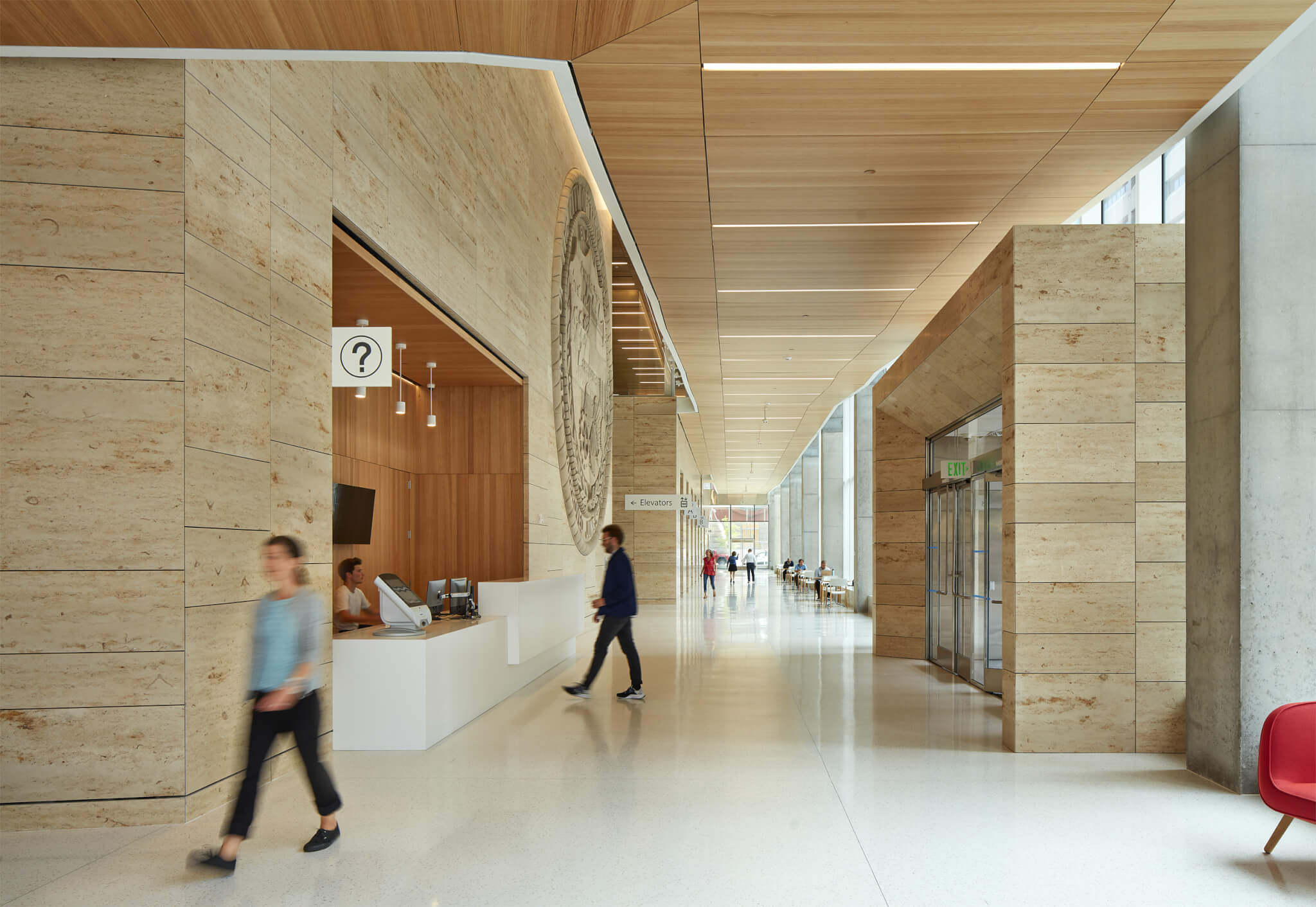
Designed for Openness
Before COVID-19, the 9/11 terrorist attacks were the last great crisis that transformed expectations for governmental design. Since then, a generation of state and federal buildings—courts, agency offices, and Federal Reserve branches—have become layered with walls, bollards, barriers, cameras, and metal detectors.
Refuting the language of fortresses, the PSB is designed as a new model for balanced security and access. When people arrive, they see destinations, not barriers. The project meets security needs while inviting people to walk directly into a double-height, light-filled lobby that runs across the building’s length.
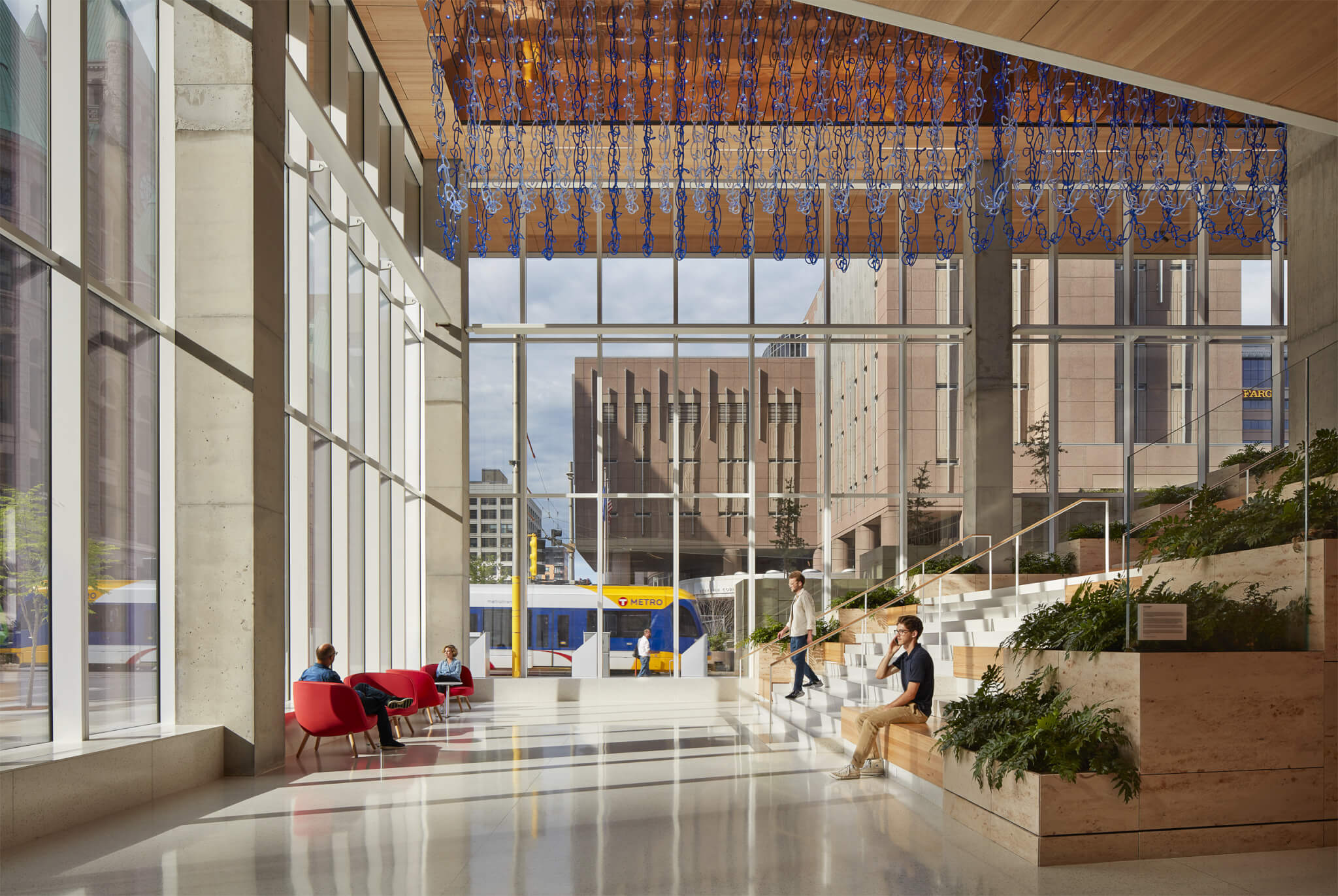
With large flexible meeting rooms on the ground floor and a long, bright yellow service desk on the second-floor skyway level, the design facilitates a new model for personal and direct government access—a one-stop shop for all city services, from paying a water bill to speaking with a planner or code official.
City leadership
The building was planned before the pandemic to consolidate nine city departments and their 1,200 employees who had been scattered across seven downtown buildings. At the time, hybrid workspaces were less relevant, and employees came to work every day. The City’s core priorities were employee collaboration, wellness, and satisfaction.
On the first level, a large flexible meeting space available to the public can be divided into sections for simultaneous events. The City directed that the public service touchpoint, the counter where visitors can access an array of services, be on the second floor. “The owner understood the programmatic spider’s web better than we did,” Eric Amel, the lead project architect for MSR, said. They knew that the public facing service counter would need back-of-house connectivity for staff, a spatial adjacency that the second floor allowed.
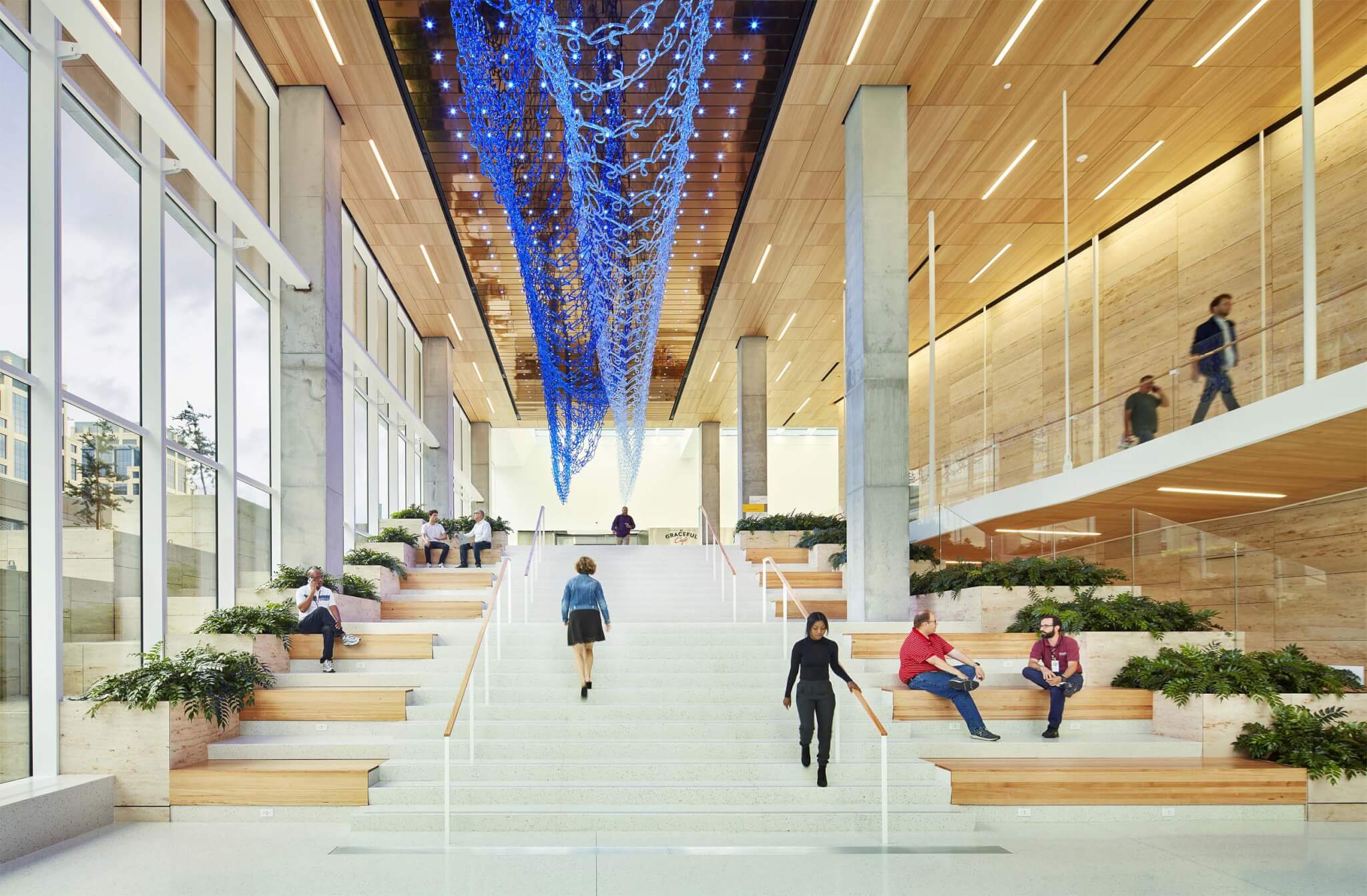
This move also isolates secure office areas from the first two floors of public access. Visual transparency and connection to the outdoors continue as the building rises upward from the public street level to the “Genius Bar” skyway level to access-controlled City offices on levels 3 to 10.
To kick-off a collaborative design process, city representatives, MSR, and Henning Larsen benchmarked public service buildings around the country to find what made them effective and customer-friendly—or not. “Getting the public service model right took some time,” Brown recalled. The team visited real-world examples helped to clarify design possibilities. With its 300-foot-long concourse, two-level public space and prominent one stop service center model, the city hall in Bellevue, Washington, by SRG Partnership proved to be an influential precedent.
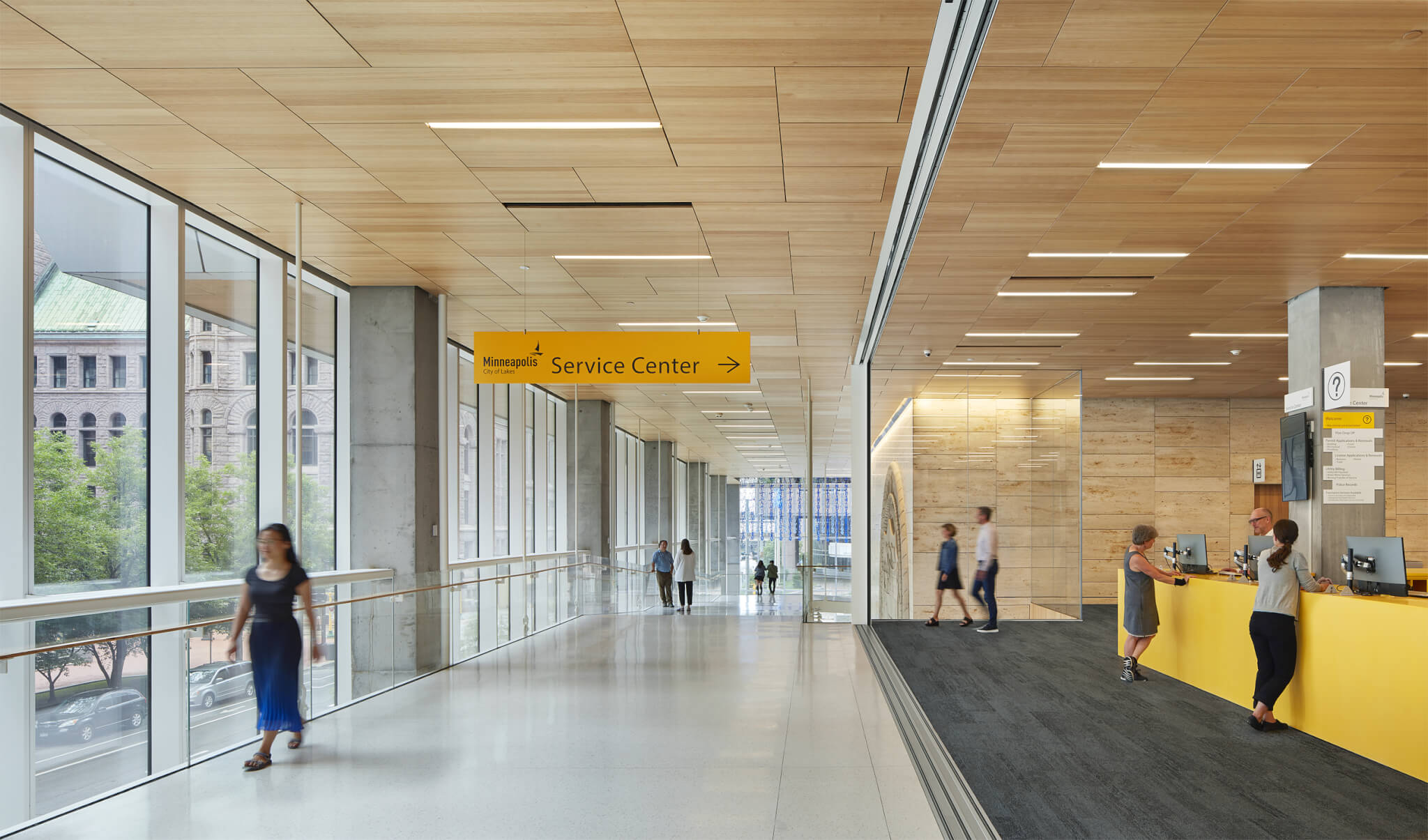
Public Access and Employee Wellness
The PSB is a model of clarity for visiting residents. It’s hard to get lost here. Retiring the old paradigm where residents had to seek out specific departments spread over varied locations, now the City brings the subject-matter experts to you at the bright yellow counter.
The architects created healthful and calming interior spaces as important tools for attracting and retaining employees. Each level offers a mix of daylit workspaces and enclosed offices, all with improved indoor air quality. The top floor hosts a conference/training room, a workout space, mother’s rooms, a staff cafe, and a terrace.
At several strategically placed points along the height of the complex, the office floors connect to one another with open staircases set in two-story volumes. These double-height spaces create visual counterpoint to the rhythmic cadence of the facade and offer views outward to the city.
These lantern-like spaces and their adjunct terraces are as much symbolic as functional. Amel said “the prominent stair expression signifies connections between departments, and the warm, hickory-clad and amply fenestrated space offers a transparent glimpse into the collaboration of the city’s personnel doing the citizens’ business.”
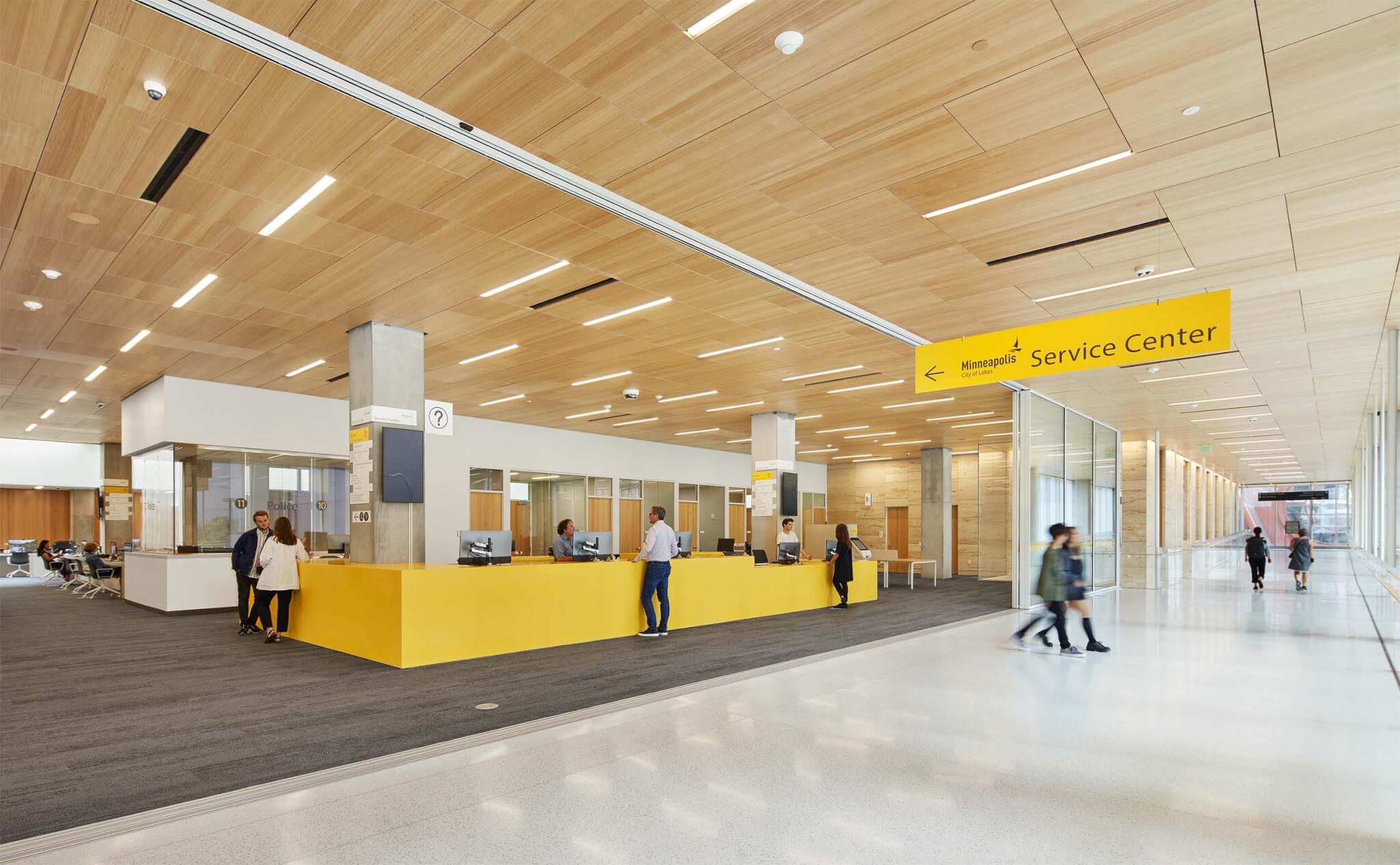
Fixing the Skyway “Problem”
Beyond improving government access, this project solves one of Minneapolis’s most vexing urban design challenges: connecting the downtown’s second level with the street. The city has the largest skyway system in the country, with 9.5 miles of pathways connecting 80 city blocks. Many progressive planners and urbanists here despise them and claim that, in privatizing circulation space, skyways take people, businesses, and vitality away from the streets. (The reasons for deadened street life are far more complicated.) There is even a Skyway Avoidance Society founded here by a group of high-end store and cafe owners in downtown’s North Loop.
During pre-design, there was controversy over whether the PSB should have any skyway access at all. Fifty years ago, Johnson/Burgee’s mixed-use IDS Center set a powerful model for gracefully connecting second level skyways with street level through its central Crystal Court. In the 1970s, this shared space became the hub of the growing skyway system.
Like the IDS Center, the PSB animates its second level with an elevated floating indoor street with daylit vistas and the aforementioned assistance counter. This pedestrian walk extends across most of the building, leading to services, activities, a cafe, and places to sit and conduct business informally.
While the Crystal Court’s views look upward to other buildings and the sky, the PSB looks outward to Government Center Plaza and the banking district. What could have been a dark internal passageway is instead an indoor civic parkway. There is a clear sense of being part of the city and making visual connections with the outdoor streets below.
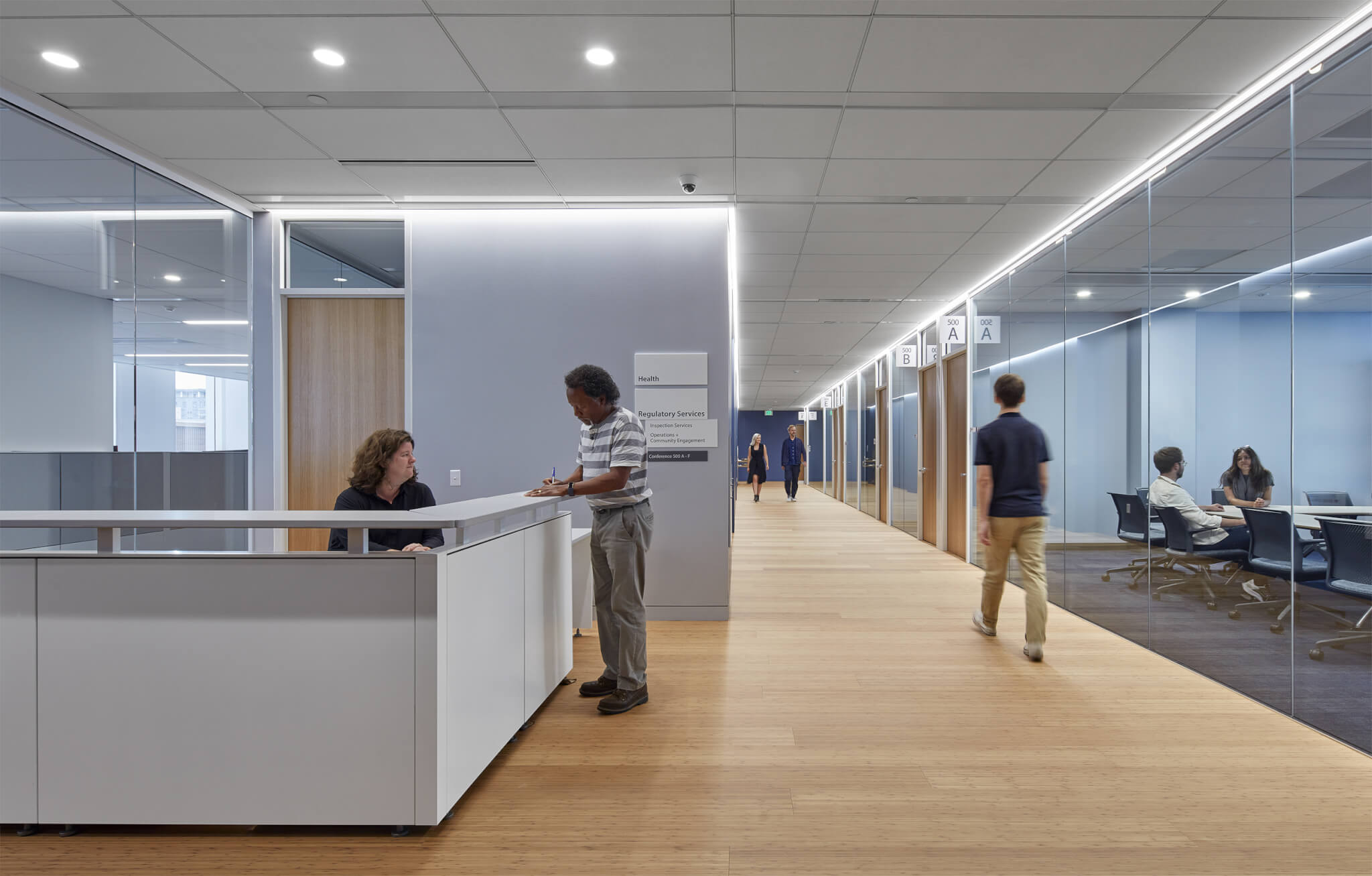
Entering from the skyway to the west, visitors arrive at the yellow public service desk. The walkway appears to be suspended as it gracefully floats through the two-story lobby with the backdrop of the Government Center Plaza and surrounding buildings. To the east, the path switchbacks near the building’s skyway-level cafe and cascades down the social stair to the block-long lobby and the plaza beyond.
Architectural drama arrives along the way. From the walkway, the panorama of downtown’s architectural palette unfolds. You can see the massive granite walls of the John Carl Warnecke’s Government Center, the travertine-clad towers of the former Pillsbury Center designed by SOM, the art deco/Zigzag Moderne Northeastern Bell Building built with warm Kasota limestone, and the castle-like Minneapolis City Hall, faced in granite.
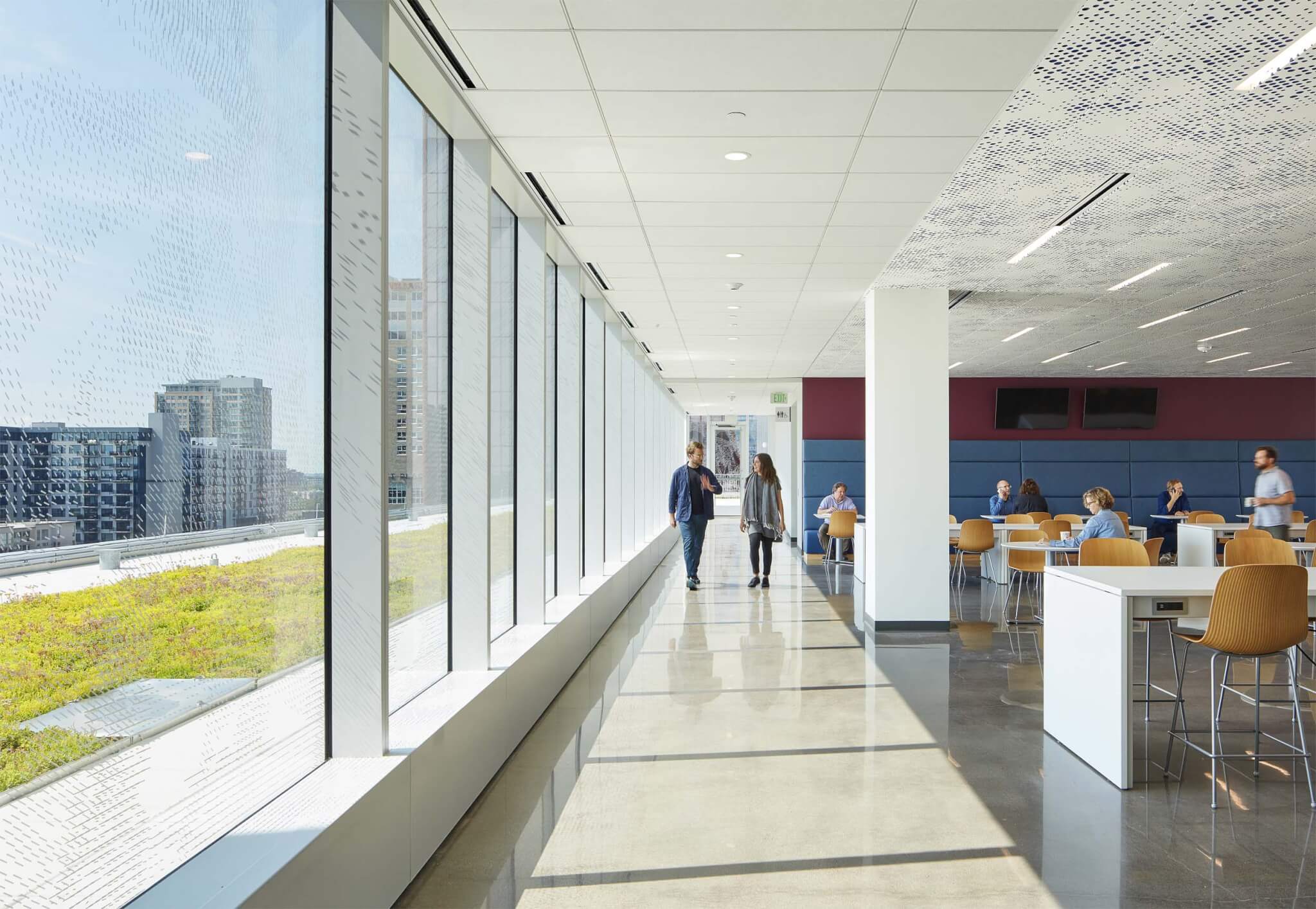
Inside, visitors encounter the Great Seal of Minneapolis, mounted on the lobby wall and visible from below on the ground level and at eye level from the skyway walk. The seal was carved from Indiana limestone in the 1960s for the old Minneapolis Auditorium and kept in storage for the last 30 years.
The PSB also connects to wider circulatory networks. This nexus of skyway and city space is also the point where Minneapolis’s skyway most closely touches the new movement system in town—the Metro light rail transit system. The immediate adjacency of the Government Center LRT Station to PSB’s generous entry and social stair connection to the city’s second level knits those systems more tightly, and further enhances the city’s commitment to equitable access for all to public services.
Facade Detailing
Amel explained that early in schematic design, Henning Larsen’s expertise with unitized facade systems helped to win city support for a construction approach that’s relatively novel for the Midwest.
Today, at first glance, the building’s visually brilliant facade is its most striking feature. Its sheer lightness livens the tone of the city’s government district and appears visually distinction from older, stone-clad institutions.
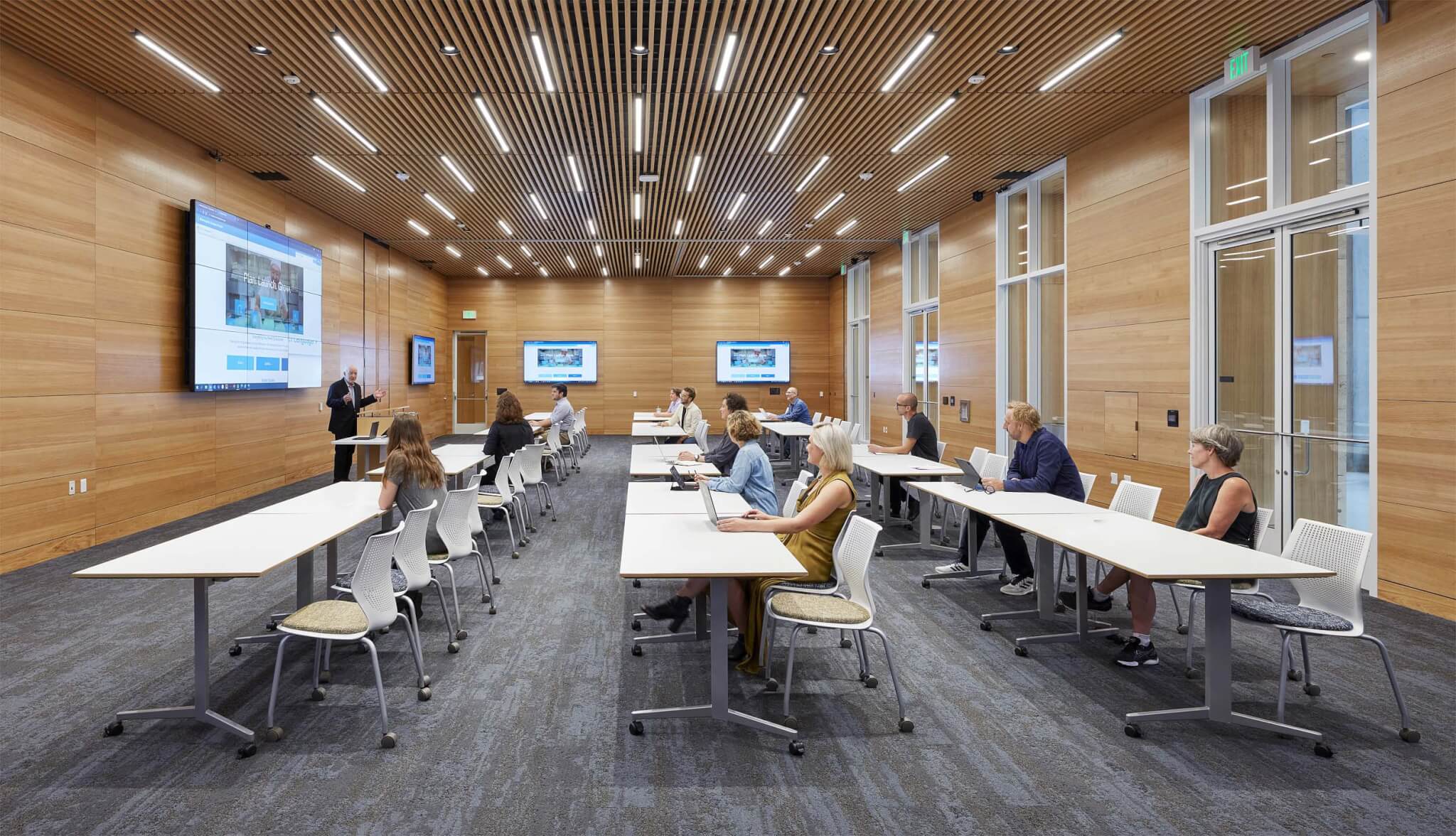
The building is wrapped with a unitized aluminum-and-glass wall system with beveled frames at every window. Faceted outward to a dimension of only 10 inches, the frames repeat across the facade, creating an illusion of depth and rhythm with very thin materials. As the sun passes during the day, the frames gleam with changing prismatic colors and contrast the full-height glass vision panels.
Henning Larsen’s Grant McCracken worked extensively on the on the facade’s detailing to create visual connections to the workings of government. He noted that, “the whole facade system is built from four 5-foot-wide panel types of different vision glass areas.” Conceived as a kit of parts, “these panels are then placed around the building in pairs, allowing variable window-to-wall ratios while maintaining a larger pattern of 10-foot wide pairs around the building.”
The flexibility of this system resposds to specific conditions around the building. McCracken shared that the angled fins “serve double duty,” he said, as they offer “a functional block to direct sunlight that would cause glare inside the workspaces as well as a surface that expresses and exaggerates the shadows cast by the facades horizontal lines throughout the day.”
The results are both aesthetic and practical. Had the building been built with additive pieces of cladding (either a stick-built or rainscreen system), its chiseled prismatic sense of depth would be lessened, window reveals would be visible, and the envelope could have been less airtight. Timing was another benefit: Traditional cladding would have taken six months, whereas the unitized panels went up in just a few weeks.
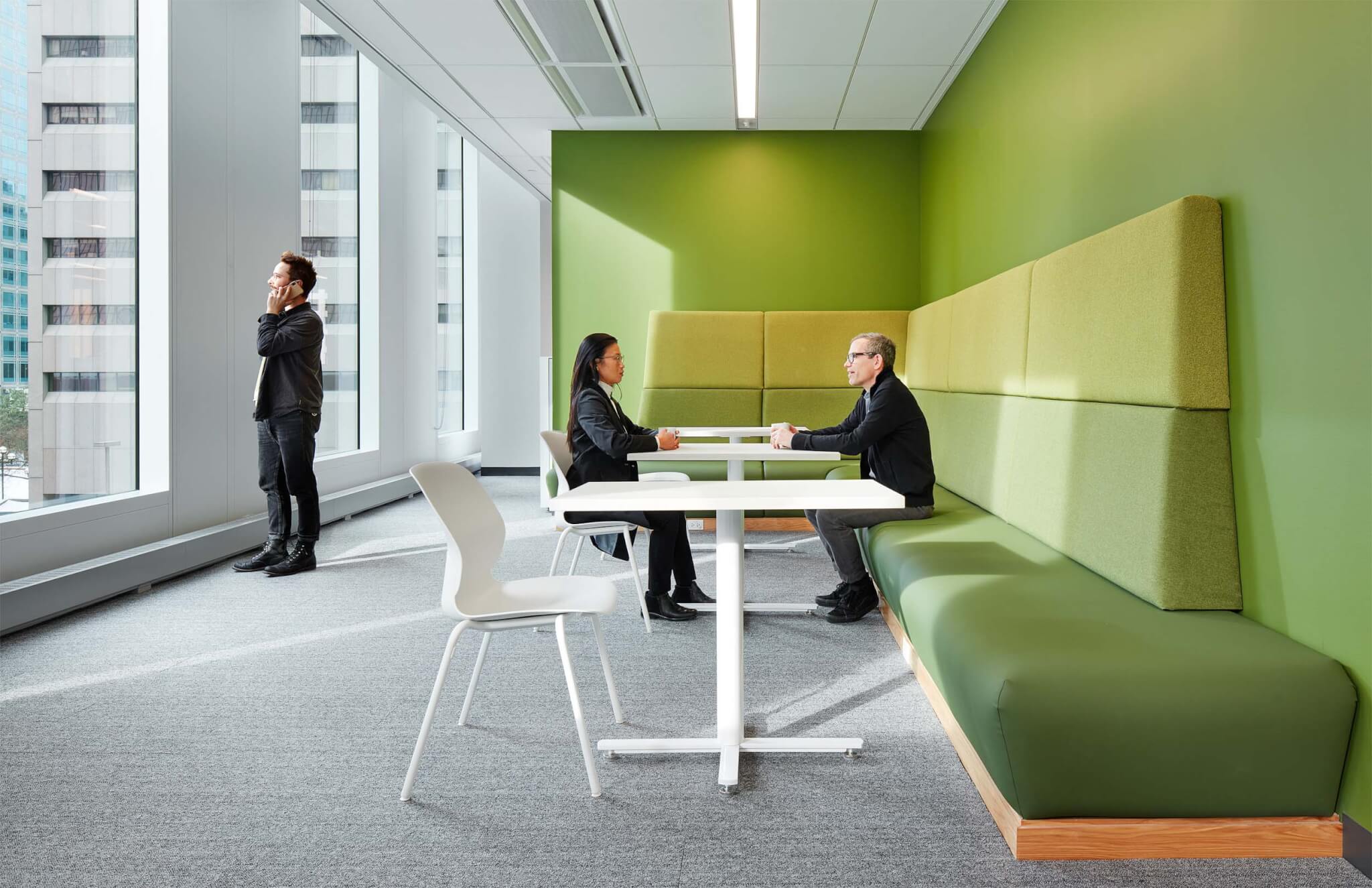
Engaging an Unknown Future
Henning Larsen continues to seek new North American work with city and community centers, each with their own site-specific challenges. Sørensen noted that as the PSB was in design, his office was also designing the new Etobicoke Civic Center in Ontario, Canada. “While similar in their northern climate, the PSB was an infill project where we were challenged to work with microclimate on a fine-grain scale—locating entrances, tailoring window sizes—to improve daily operations and experience.” In contrast, “Etobicoke’s design was sculpted at the site planning and massing scale to frame a public plaza that would extend the comfortable temperature range in shoulder seasons by nearly five weeks.”
With the inherent locality of climate, site, and culture coupled with the unknown future of politics and technology, creating a contemporary architecture for civic buildings is a challenging task. The PSB is now a model for flexible, multi-use spaces that can accommodate rapid evolution in technologies and city administration. Still, no one could have predicted the pandemic. When the building slowly opened to staff at the end of 2021, many worked from home or assumed a hybrid schedule. It remains to be seen how the building will be used in full occupancy, if that ever happens.

In city centers across the country, many urban office and retail structures are being eyed for conversion to residential use. COVID-19 only accelerated the discarding of 20th-century shopping and business practices. Fifty years from now, the Minneapolis Public Service Building may achieve uses and civic benefits that were never part of the plan.
Looking forward, this capacity to engage unplanned futures is part of what makes a great civic building. With green technologies that sharply reduce environmental and energy impacts and its anticipated 100-year life span, the PSB is exactly what the city sought, said City Council member Lisa Goodman. Minneapolis was never looking for a grand building, but a lasting one. “We’re not spending money on a building or its architecture,” Goodman said, “we’re investing in the people working there and the people they serve.”
Frank Edgerton Martin is a landscape historian, architectural writer, and design journalist.
- Architect: Henning Larsen
- Architect of record: MSR Design
- Landscape architect: Coen+Partners
- Structural, mechanical, and electrical engineer: Buro Happold
- Plumbing and fire protection engineer: Obernel Engineering
- Civil engineer: EVS
- Construction manager: Mortenson







